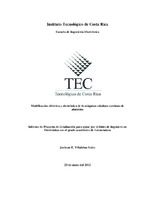Mostrar el registro sencillo del ítem
Modificación eléctrica y electrónica de la máquina coladora continua de aluminio
| dc.contributor.author | Villalobos-Lobo, Jocksan | |
| dc.date.accessioned | 2013-02-04T01:21:45Z | |
| dc.date.available | 2013-02-04T01:21:45Z | |
| dc.date.issued | 2012 | |
| dc.identifier.uri | https://hdl.handle.net/2238/2965 | |
| dc.description | Proyecto de Graduación (Licenciatura en Ingeniería Electrónica) Instituto Tecnológico de Costa Rica, Escuela de Ingeniería Electrónica, 2012. | es |
| dc.description.abstract | La empresa CVG ALUNASA trabaja en la elaboración de productos a base de aluminio. Para extraer el aluminio y formarlo en láminas se requiere el uso de la máquina coladora continua. Parte principal de la misma es el sistema mecánico encargado de girar los rodillos que dan la forma y dimensión a dichas láminas. El objetivo del proyecto es reemplazar el sistema mecánico por uno más eficiente y de mayor capacidad, y diseñar e implementar un sistema de control que responda ante cambios físicos que se realicen en los rodillos. Debido a que el sistema anterior estaba al límite de su capacidad y presentaba problemas tanto mecánicos como de control. El sistema mecánico hace girar los rodillos a una velocidad determinada y con una precarga en estos para dar el espesor a la lámina, estos factores definen la potencia suministrada por el sistema. Con la velocidad máxima necesaria para la producción y el torque, se calculó la potencia que debe suministrar el nuevo sistema mecánico, conformado por dos motores y sus reductores de velocidad planetarios. Se diseñó un sistema de control síncrono programado en dos variadores de frecuencia, para la regulación de la velocidad y sincronía de los motores, y una pantalla LCD táctil que brinda datos relevantes del proceso, alarmas y permite al operador la introducción de parámetros de control. _________________________________________________________________________ Abstract: CVG ALUNASA working on the development of aluminum products. To extract the aluminum and make de aluminum foil it’s require the use of the continuous casting machine. Main part of this machine is the mechanical system, that is responsible for spinning the roller that shape and give dimension to the foil. The objective of this project is to replace the mechanical system to a more efficient with higher capacity system and the designing and implementation of a control system that responds to physical changes that take place on the rollers. Those changes are because the previous system was in the limit of its capacity and had mechanical and control problems. The mechanical system rotate the rollers at the necessary rate of speed with the preload on the rollers to give thickness to the sheet, these factors give the power supplied by the system. With the maximum speed and the torque value the power that must be supplied for the new mechanical system was calculated, consisting of two motors and planetary gearboxes. A synchronous control system was designed and programmed in two variable frequency drives, to regulate the speed and the synchronization of the motor, and one LCD touch screen was programmed to provides relevant process data, alarms and allows the operator the introduction of control parameters. | es |
| dc.language.iso | es | es |
| dc.publisher | Instituto Tecnológico de Costa Rica. Escuela de Electrónica | es |
| dc.rights | acceso abierto | es |
| dc.subject | Coladora continua | es |
| dc.subject | Precarga | es |
| dc.subject | Reductor de velocidad planetario | es |
| dc.subject | Continuous casting | es |
| dc.subject | Planetary gearboxes | es |
| dc.subject | Preload | es |
| dc.title | Modificación eléctrica y electrónica de la máquina coladora continua de aluminio | es |
| dc.type | proyecto fin de carrera | es |


